Papers by Robin Augustine
Progress in Biomaterials, 2016
Development of materials for medical applications using biologically derived materials by green a... more Development of materials for medical applications using biologically derived materials by green approaches is emerging as an important focus in the present healthcare scenario. Herein the first time, we report the plant extract mediated ultra-rapid biosynthesis of silver nanoparticles using whole plant extracts of Biophytum sensitivum. Synthesized nanoparticles were immobilized in nano-micro dual-porous calcium pectinate scaffolds for wound dressing application. Pectinate wound dressings containing silver nanoparticles have shown excellent antibacterial property and exudate uptake capacity while being biocompatible to the human cells.
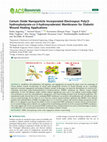
ACS Biomaterials Science & Engineering, 2018
Insufficient cell proliferation, cell migration, and angiogenesis are among the major causes for ... more Insufficient cell proliferation, cell migration, and angiogenesis are among the major causes for nonhealing of chronic diabetic wounds. Incorporation of cerium oxide nanoparticles (nCeO 2) in wound dressings can be a promising approach to promote angiogenesis and healing of diabetic wounds. In this paper, we report the development of a novel nCeO 2 containing electrospun poly(3-hydroxybutyrate-co-3-hydroxyvalerate) (PHBV) membrane for diabetic wound healing applications. In vitro cell adhesion studies, chicken embryo angiogenesis assay, and in vivo diabetic wound healing studies were performed to assess the cell proliferation, angiogenesis, and wound healing potential of the developed membranes. The experimental results showed that nCeO 2 containing PHBV membranes can promote cell proliferation and cell adhesion when used as wound dressings. For less than 1% w/w of nCeO 2 content, human mammary epithelial cells (HMEC) were adhered parallel to the individual fibers of PHBV. For higher than 1% w/w of nCeO 2 content, cells started to flatten and spread over the fibers. In ovo angiogenic assay showed the ability of nCeO 2 incorporated PHBV membranes to enhance blood vessel formation. In vivo wound healing study in diabetic rats confirmed the wound healing potential of nCeO 2 incorporated PHBV membranes. The study suggests that nCeO 2 incorporated PHBV membranes have strong potential to be used as wound dressings to enhance cell proliferation and vascularization and promote the healing of diabetic wounds.
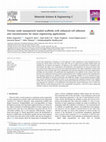
Materials Science and Engineering: C, 2019
In situ tissue engineering is emerging as a novel approach in tissue engineering to repair damage... more In situ tissue engineering is emerging as a novel approach in tissue engineering to repair damaged tissues by boosting the natural ability of the body to heal itself. This can be achieved by providing suitable signals and scaffolds that can augment cell migration, cell adhesion on the scaffolds and proliferation of endogenous cells that facilitate the repair. Lack of appropriate cell proliferation and angiogenesis are among the major issues associated with the limited success of in situ tissue engineering during in vivo studies. Exploitation of metal oxide nanoparticles such as yttrium oxide (Y 2 O 3) nanoparticles may open new horizons in in situ tissue engineering by providing cues that facilitate cell proliferation and angiogenesis in the scaffolds. In this context, Y 2 O 3 nano-particles were synthesized and incorporated in polycaprolactone (PCL) scaffolds to enhance the cell proliferation and angiogenic properties. An optimum amount of Y 2 O 3-containing scaffolds (1% w/w) promoted the proliferation of fibroblasts (L-929) and osteoblast-like cells (UMR-106). Results of chorioallantoic membrane (CAM) assay and the subcutaneous implantation studies in rats demonstrated the angiogenic potential of the scaffolds loaded with Y 2 O 3 nanoparticles. Gene expression study demonstrated that the presence of Y 2 O 3 in the scaffolds can upregulate the expression of cell proliferation and angiogenesis related biomolecules such as VEGF and EGFR. Obtained results demonstrated that Y 2 O 3 nanoparticles can perform a vital role in tissue engineering scaffolds to promote cell proliferation and angiogenesis.
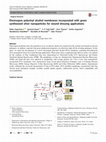
Journal of Materials Science: Materials in Medicine, 2018
Electrospun membranes have the potential to act as an effective barrier for wounds from the exter... more Electrospun membranes have the potential to act as an effective barrier for wounds from the external environment to prevent pathogens. In addition, materials with good antibacterial properties can effectively fight off the invading pathogens. In this paper, we report the development of a novel electrospun polyvinyl alcohol (PVA) membrane containing biosynthesized silver nanoparticle (bAg) for wound dressing applications. Plant extract from a medicinal plant Mimosa pudica was utilized for the synthesis of bAg. Synthesized bAg were characterized by Ultraviolet-Visible (UV) Spectroscopy and Fourier Transform Infrared Spectroscopy (FTIR). The morphology of bAg was obtained from Transmission Electron Microscopy (TEM) and found that they were spherical in morphology with average particle size 7.63 ± 1.2 nm. bAg nanoparticles incorporated PVA membranes were characterized using several physicochemical techniques such as Scanning Electron Microscopy (SEM), Energy Dispersive X-Ray Spectroscopy (EDS) and X-Ray Diffraction (XRD) analysis. Experimental results confirmed the successful incorporation of bAg in PVA fibers. PVA nanofiber membranes incorporated with bAg showed good mechanical strength, excellent exudate uptake capacity, antibacterial activity, blood compatibility and cytocompatibility. Graphical Abstract * Robin Augustine robin@robinlab.in
Progress in Biomaterials, 2016
Development of materials for medical applications using biologically derived materials by green a... more Development of materials for medical applications using biologically derived materials by green approaches is emerging as an important focus in the present healthcare scenario. Herein the first time, we report the plant extract mediated ultra-rapid biosynthesis of silver nanoparticles using whole plant extracts of Biophytum sensitivum. Synthesized nanoparticles were immobilized in nano-micro dual-porous calcium pectinate scaffolds for wound dressing application. Pectinate wound dressings containing silver nanoparticles have shown excellent antibacterial property and exudate uptake capacity while being biocompatible to the human cells.
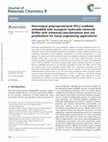
J. Mater. Chem. B, , 2017
Electrospun polycaprolactone (PCL) tissue engineering scaffolds have been developed and used for ... more Electrospun polycaprolactone (PCL) tissue engineering scaffolds have been developed and used for a wide range of tissue engineering applications, where successful incorporation and conservation of the therapeutic activity of the embedded nanoparticles into scaffolds is critically needed for effective tissue engineering. Incorporation of pro-angiogenic nanomaterials to promote vascularization is a novel approach. Our group has well-demonstrated the potent pro-angiogenic properties of europium hydroxide nanorods (EHNs) using in vitro and in vivo systems. In the present study, electrospun PCL tissue engineering scaffolds containing EHNs were fabricated and characterized for various morphological and physico-chemical properties. Furthermore, biological studies showed enhanced cell growth and a greater density of endothelial cells grown on the scaffolds incorporated with EHNs (PCL-EHNs). The PCL-EHNs also exhibited good hemo-compatibility towards blood cells. Fluorescence microscopy and SEM observations showed good endothelial cell adhesion over these scaffolds. The PCL-EHNs demonstrated augmented growth of blood vessels in an in vivo chick embryo angiogenesis model. Furthermore, protein expression studies illustrated promoted angiogenesis of HUVECs on scaffolds in a VEGFR2/Akt mediated signaling cascade. Together, the above observations strongly suggest potent applications of EHN-incorporated PCL scaffolds in promoting angiogenesis/vascularization and their effective use in tissue engineering and vascular disease therapy.
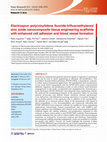
Nano Research, 2017
Piezoelectric materials that generate electrical signals in response to mechanical strain can be ... more Piezoelectric materials that generate electrical signals in response to mechanical strain can be used in tissue engineering to stimulate cell proliferation. Poly (vinylidene fluoride-trifluoroethylene) (P(VDF-TrFE)), a piezoelectric polymer, is widely used in biomaterial applications. We hypothesized that incorporation of zinc oxide (ZnO) nanoparticles into the P(VDF-TrFE) matrix could promote adhesion, migration, and proliferation of cells, as well as blood vessel formation (angiogenesis). In this study, we fabricated and comprehensively characterized a novel electrospun P(VDF-TrFE)/ZnO nanocomposite tissue engineering scaffold. We analyzed the morphological features of the polymeric matrix by scanning electron microscopy, and utilized Fourier transform infrared spectroscopy, X-ray diffraction, and differential scanning calorimetry to examine changes in the crystalline phases of the copolymer due to addition of the nanoparticles. We detected no or minimal adverse effects of the biomaterials with regard to blood compatibility in vitro, biocompatibility, and cytotoxicity, indicating that P(VDF-TrFE)/ZnO nanocomposite scaffolds are suitable for tissue engineering applications. Interestingly, human mesenchymal stem cells (hMSCs) and human umbilical vein endothelial cells cultured on the nanocomposite scaffolds exhibited higher cell viability, adhesion, and proliferation compared to cells cultured on tissue culture plates or neat P(VDF-TrFE) scaffolds. Nanocomposite scaffolds implanted into rats with or without hMSCs did not elicit immunological responses, as assessed by macroscopic analysis and histology. Importantly, nanocomposite scaffolds promoted angiogenesis, which was increased in scaffolds pre-seeded with hMSCs. Overall, our results highlight the potential of these novel P(VDF-TrFE)/ZnO nanocomposites for use in tissue engineering, due to their biocompatibility and ability to promote cell adhesion and angiogenesis.
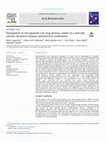
Acta Biomaterialia, 2018
Nanonization has been extensively investigated to increase the oral bioavailability of hydropho-b... more Nanonization has been extensively investigated to increase the oral bioavailability of hydropho-bic drugs in general and antiretrovirals (ARVs) used in the therapy of the human immunodeficiency virus (HIV) infection in particular. We anticipated that in the case of protease inhibitors, a family of pH-dependent ARVs that display high aqueous solubility under the acid conditions of the stomach and extremely low solubility under the neutral ones of the small intestine, this strategy might fail owing to an uncontrolled dissolution-re-precipitation process that will take place along the gastrointestinal tract. To tackle this biopharmaceutical challenge, in this work, we designed, produced and fully characterized a novel Nanoparticle-in-Microparticle Delivery System (NiMDS) comprised of pure nanoparticles of the-first-line protease inhibitor darunavir (DRV) and its boosting agent ritonavir (RIT) encapsulated within film-coated microparticles. For this, a clinically relevant combination of pure DRV and RIT nanoparticles was synthesized by a sequential nanoprecipitation/solvent diffusion and evaporation method employing sodium alginate as viscosity stabilizer. Then, pure nanoparticles were encapsulated within calcium alginate/chitosan microparticles that were film-coated with a series of poly(methacrylate) copolymers with differential solubility in the gastrointestinal tract. This coating ensured full stability under gastric-like pH and sustained drug release under intestinal one. Pharmacokinetic studies conducted in albino Sprague Dawley rats showed that DRV/RIT-loaded NiMDSs containing 17% w/w drug loading based on dry weight significantly increased the oral bioavailability of DRV by 2.3-fold with respect to both the unprocessed and the nanonized DRV/RIT combinations that showed statistically similar performance. Moreover, they highlighted the limited advantage of only drug nanonization to improve the oral pharmacokinetics of protease inhibitors and the potential of our novel delivery approach to improve the oral pharmacokinetics of nanonized poorly water-soluble drugs displaying pH-dependent solubility. Statement of significance Protease inhibitors (PIs) are gold-standard drugs in many ARV cocktails. Darunavir (DRV) is the latest approved PI and it is included in the 20th WHO Model List of Essential Medicines. PIs poorly-water soluble at intestinal pH and more soluble under gastric conditions. Drug nanonization represents one of the most common nanotechnology strategies to increase dissolution rate of hydrophobic drugs and thus, their oral bioavailability. For instance, pure drug nanosuspen-sions became the most clinically relevant nanoformulation. However, according to the physicochemical properties of PIs, nanonization does not appear as a very beneficial strategy due to the fast dissolution rate anticipated under the acid conditions of the stomach and their uncontrolled recrystallization and precipitation in the small intestine that might result in the formation of particles of unpredictable size and structure (e.g., crystallinity and polymorphism) and consequently, unknown dissolution rate and bioavailability. In this work, we developed a sequential nanoprecipitation method for the production of pure nanopar-ticles of DRV and its boosting agent ritonavir in a clinically relevant 8:1 wt ratio using alginate as viscosity stabilizer and used this nanosuspension to produce a novel kind of nanoparticle-in-microparticle delivery system that was fully characterized and the pharmacokinetics assessed in rats. The most significant points of the current manuscript are: 1) Development of a sequential nanoprecipitation method to produce a fixed-dose combination of two antiretrovirals 2) Design and characterization of a novel kind of nanoparticle-in-microparticle drug delivery system with high stability and low drug release in the stomach 3) Demonstration for the first time of the lack of benefit of only drug nanonization in protease inhibitors 4) Design of a new protocol for oral administration of solid formulations in rodents 5) Achievement of significant increase of the oral bioavailability of darunavir 6) Opening of new opportunities for more efficacious oral delivery of hydrophobic drug
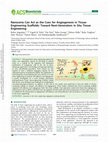
ACS Biomaterials Science & Engineering, 2018
Next-generation tissue engineering exploits the body's own regenerative capacity by providing an ... more Next-generation tissue engineering exploits the body's own regenerative capacity by providing an optimal niche via a scaffold for the migration and subsequent proliferation of endogenous cells to the site of injury, enhancing regeneration and healing and bypassing laborious in vitro cell-culturing procedures. Such systems are also required to have a sufficient angiogenic capacity for the subsequent patency of implanted scaffolds. The exploitation of redox properties of nanodimensional ceria (nCeO 2) in in situ tissue engineering to promote cell adhesion and angiogenesis is poorly investigated. As a novel strategy, electrospun polycaprolactone based tissue-engineering scaffolds loaded with nCeO 2 were developed and evaluated for morphological and physicomechanical features. In addition, in vitro and in vivo studies were performed to show the ability of nCeO 2-containing scaffolds to enhance cell adhesion and angiogenesis. These studies confirmed that nCeO 2-containing scaffolds supported cell adhesion and angiogenesis better than bare scaffolds. Gene-expression studies had shown that angiogenesis-related factors such as HIF1α and VEGF were up-regulated. Overall results show that incorporation of nCeO 2 plays a key role in scaffolds for the enhancement of angiogenesis, cell adhesion, and cell proliferation and can produce a successful outcome in in situ tissue engineering.
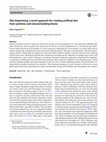
Progress in Biomaterials, 2018
Significant progress has been made over the past few decades in the development of in vitro-engin... more Significant progress has been made over the past few decades in the development of in vitro-engineered substitutes that mimic human skin, either as grafts for the replacement of lost skin, or for the establishment of in vitro human skin models. Tissue engineering has been developing as a novel strategy by employing the recent advances in various fields such as polymer engineering, bioengineering, stem cell research and nanomedicine. Recently, an advancement of 3D printing technology referred as bioprinting was exploited to make cell loaded scaffolds to produce constructs which are more matching with the native tissue. Bioprinting facilitates the simultaneous and highly specific deposition of multiple types of skin cells and biomaterials, a process that is lacking in conventional skin tissue-engineering approaches. Bioprinted skin substitutes or equivalents containing dermal and epidermal components offer a promising approach in skin bioengineering. Various materials including synthetic and natural biopolymers and cells with or without signalling molecules like growth factors are being utilized to produce functional skin constructs. This technology emerging as a novel strategy to overcome the current bottlenecks in skin tissue engineering such as poor vascularization, absence of hair follicles and sweat glands in the construct.
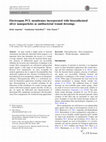
An open wound is highly prone to bacterial colonization and infection. Bacterial barrier property... more An open wound is highly prone to bacterial colonization and infection. Bacterial barrier property is an important factor that determines the success of a wound coverage material. Apart from the bacterial barrier property , presence of antibacterial agents can successfully eliminate the invasion and colonization of pathogen in the wound. Silver nanoparticles are well-known antimicrobial agents against a wide range of microorganisms. Biosyn-thesized silver nanoparticles are more acceptable for medical applications due to superior biocompatibility than chemically synthesized ones. Presence of biomolecules on biosynthesized silver nanoparticles enhances its therapeutic efficiency. Polycaprolactone (PCL) is a well-known material for biomedical applications including wound dress-ings. Electrospinning is an excellent technique for the fabrication of thin membranes for wound coverage applications with barrier property against microbes. In this paper , we report the fabrication and characterization of electrospun PCL membranes incorporated with biosynthe-sized silver nanoparticles for wound dressing applications.
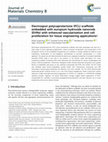
Electrospun polycaprolactone (PCL) tissue engineering scaffolds have been developed and used for ... more Electrospun polycaprolactone (PCL) tissue engineering scaffolds have been developed and used for a wide range of tissue engineering applications, where successful incorporation and conservation of the therapeutic activity of the embedded nanoparticles into scaffolds is critically needed for effective tissue engineering. Incorporation of pro-angiogenic nanomaterials to promote vascularization is a novel approach. Our group has well-demonstrated the potent pro-angiogenic properties of europium hydroxide nanorods (EHNs) using in vitro and in vivo systems. In the present study, electrospun PCL tissue engineering scaffolds containing EHNs were fabricated and characterized for various morphological and physico-chemical properties. Furthermore, biological studies showed enhanced cell growth and a greater density of endothelial cells grown on the scaffolds incorporated with EHNs (PCL-EHNs). The PCL-EHNs also exhibited good hemo-compatibility towards blood cells. Fluorescence microscopy and SEM observations showed good endothelial cell adhesion over these scaffolds. The PCL-EHNs demonstrated augmented growth of blood vessels in an in vivo chick embryo angiogenesis model. Furthermore, protein expression studies illustrated promoted angiogenesis of HUVECs on scaffolds in a VEGFR2/Akt mediated signaling cascade. Together, the above observations strongly suggest potent applications of EHN-incorporated PCL scaffolds in promoting angiogenesis/vascularization and their effective use in tissue engineering and vascular disease therapy.
Electrospun poly-ƹ-caprolactone/zinc oxide (PCL/ZnO) nanocomposite scaffolds were reported for ti... more Electrospun poly-ƹ-caprolactone/zinc oxide (PCL/ZnO) nanocomposite scaffolds were reported for tissue engineering and wound healing applications. Wound coverage materials should have good barrier property against invading microbes. Since wound coverage materials and tissue engineering scaffolds are in direct contact with blood, such materials should be blood compatible. Thus, blood compatibility of the fabricated scaffolds has been tested by RBC and WBC aggregation studies. Hemolysis assay and platelet activation study were also carried out. This study is promising in the sense that the fabricated scaffolds showed excellent microbial barrier property and were highly compatible with RBC and WBC and did not induce haemolysis. However, need to be vigilant regarding the possible platelet aggregation that can happen at higher concentrations of ZnO nanoparticles.
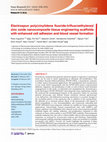
Piezoelectric materials that generate electrical signals in response to mechanical strain can be ... more Piezoelectric materials that generate electrical signals in response to mechanical strain can be used in tissue engineering to stimulate cell proliferation. Poly (vinylidene fluoride-trifluoroethylene) (P(VDF-TrFE)), a piezoelectric polymer, is widely used in biomaterial applications. We hypothesized that incorporation of zinc oxide (ZnO) nanoparticles into the P(VDF-TrFE) matrix could promote adhesion, migration, and proliferation of cells, as well as blood vessel formation (angiogenesis). In this study, we fabricated and comprehensively characterized a novel electrospun P(VDF-TrFE)/ZnO nanocomposite tissue engineering scaffold. We analyzed the morphological features of the polymeric matrix by scanning electron microscopy, and utilized Fourier transform infrared spectroscopy, X-ray diffraction, and differential scanning calorimetry to examine changes in the crystalline phases of the copolymer due to addition of the nanoparticles. We detected no or minimal adverse effects of the biomaterials with regard to blood compatibility in vitro, biocompatibility, and cytotoxicity, indicating that P(VDF-TrFE)/ZnO nanocomposite scaffolds are suitable for tissue engineering applications. Interestingly, human mesenchymal stem cells (hMSCs) and human umbilical vein endothelial cells cultured on the nanocomposite scaffolds exhibited higher cell viability, adhesion, and proliferation compared to cells cultured on tissue culture plates or neat P(VDF-TrFE) scaffolds. Nanocomposite scaffolds implanted into rats with or without hMSCs did not elicit immunological responses, as assessed by macroscopic analysis and histology. Importantly, nanocomposite scaffolds promoted angiogenesis, which was increased in scaffolds pre-seeded with hMSCs. Overall, our results highlight the potential of these novel P(VDF-TrFE)/ZnO nanocomposites for use in tissue engineering, due to their biocompatibility and ability to promote cell adhesion and angiogenesis.
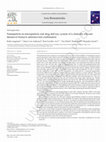
Nanonization has been extensively investigated to increase the oral bioavailability of hydrophobi... more Nanonization has been extensively investigated to increase the oral bioavailability of hydrophobic drugs in
general and antiretrovirals (ARVs) used in the therapy of the human immunodeficiency virus (HIV) infection
in particular. We anticipated that in the case of protease inhibitors, a family of pH-dependent ARVs that display
high aqueous solubility under the acid conditions of the stomach and extremely low solubility under the
neutral ones of the small intestine, this strategy will fail owing to an uncontrolled dissolution-re-precipitation
process that will take place along the gastrointestinal tract. To tackle this biopharmaceutical challenge,
in this work, we designed, produced and fully characterized a novel Nanoparticle-in-Microparticle Delivery
System (NiMDS) comprised of pure nanoparticles of the first-line protease inhibitor darunavir (DRV)
and its boosting agent ritonavir (RIT) encapsulated within film-coated microparticles. For this, a clinically
relevant combination of pure DRV and RIT nanoparticles was synthesized by a sequential nanoprecipitation/
solvent diffusion and evaporation method employing sodium alginate as viscosity stabilizer. Then, pure
nanoparticles were encapsulated within calcium alginate/chitosan microparticles that were film-coated with
a series of poly(methacrylate) copolymers with differential solubility in the gastrointestinal tract. This coating
ensured full stability under gastric-like pH and sustained drug release under intestinal one. Pharmacokinetic
studies conducted in albino Sprague Dawley rats showed that DRV/RIT-loaded NiMDSs containing
17% w/w drug loading based on dry weight significantly increased the oral bioavailability of DRV by
2.3-fold with respect to both the unprocessed and the nanonized DRV/RIT combinations that showed statistically
similar performance. Moreover, they highlighted the limited advantage of drug nanonization to improve
the oral pharmacokinetics of protease inhibitors and the potential of our novel delivery approach to improve
the oral pharmacokinetics of nanonized poorly water-soluble drugs displaying pH-dependent solubility.
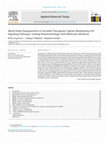
Nanoparticles exhibit properties different from their bulk counterparts and the unique properties... more Nanoparticles exhibit properties different from their bulk counterparts and the unique properties make them highly appealing for wide variety of biomedical applications. Inorganic nanoparticles have attracted much interest in biology and medicine and particularly metal oxide nanoparticles (MONPs) have become versatile platforms for diagnostic and therapeutic interventions. MONPs are well studied for their ability to induce the generation of reactive oxygen species (ROS) by cells in the presence and absence of irradiation under a wide range of conditions. ROS have been reported to trigger different pathological events due to oxidative stress including genotoxicity and fibrosis. Despite these adverse effects, recent reports on the effects of ROS have highlighted that MONPs are cytotoxic only at high concentrations and that at lower ones, they could play key roles in cell proliferation, migration, apoptosis, and the immune system. In addition to their proven beneficial role in wound healing, MONPs have been increasingly investigated in areas such as cell signaling and tissue engineering. First, this review comprehensively overviews the therapeutic potential of MONPs mediated by the generation of ROS. Then, it deals with their application in tissue engineering, wound healing, and cancer therapy with emphasis on the biomolecular signaling mechanisms. Finally, controversial aspects of these nanomaterials that emerge from the most recent scientific literature are discussed.
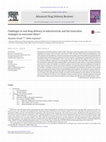
Development of novel drug delivery systems (DDS) represents a promising opportunity to overcome t... more Development of novel drug delivery systems (DDS) represents a promising opportunity to overcome the various bottlenecks associated with the chronic antiretroviral (ARV) therapy of the human immunodeficiency virus (HIV) infection. Oral drug delivery is the most convenient and simplest route of drug administration that involves the swallowing of a pharmaceutical compound with the intention of releasing it into the gastrointestinal tract. In oral delivery, drugs can be formulated in such a way that they are protected from digestive enzymes, acids, etc. and released in different regions of the small intestine and/or the colon. Not surprisingly, with the exception of the subcutaneous enfuvirtide, all the marketed ARVs are administered orally. However, conventional (marketed) and innovative (under investigation) oral delivery systems must overcome numerous challenges, including the acidic gastric environment, and the poor aqueous solubility and physicochemical instability of many of the approved ARVs. In addition, the mucus barrier can prevent penetration and subsequent absorption of the released drug, a phenomenon that leads to lower oral bioavailability and therapeutic concentration in plasma. Moreover, the frequent administration of the cocktail (ARVs are administered at least once a day) favors treatment interruption. To improve the oral performance of ARVs, the design and development of more efficient oral drug delivery systems are called for. The present review highlights various innovative research strategies adopted to overcome the limitations of the present treatment regimens and to enhance the efficacy of the oral ARV therapy in HIV.
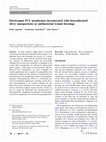
An open wound is highly prone to bacterial colonization and infection. Bacterial barrier property... more An open wound is highly prone to bacterial colonization and infection. Bacterial barrier property is an important factor that determines the success of a wound coverage material. Apart from the bacterial barrier property, presence of antibacterial agents can successfully eliminate the invasion and colonization of pathogen in the wound. Silver nanoparticles are well-known antimicrobial agents against a wide range of microorganisms. Biosynthesized silver nanoparticles are more acceptable for medical applications due to superior biocompatibility than chemically synthesized ones. Presence of biomolecules on biosynthesized silver nanoparticles enhances its therapeutic efficiency. Polycaprolactone (PCL) is a well-known material for biomedical applications including wound dressings. Electrospinning is an excellent technique for the fabrication of thin membranes for wound coverage applications with barrier property against microbes. In this paper, we report the fabrication and characterization of electrospun PCL membranes incorporated with biosynthesized silver nanoparticles for wound dressing applications.
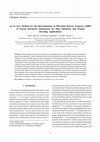
Barrier property of materials to microbes is an important aspect in many applications like wound ... more Barrier property of materials to microbes is an important aspect in many applications like wound dressings and skin substitutes. Lack of a standard method for the evaluation of microbial barrier property limits the consideration of this important aspect by many bioengineers and biomaterial scientists. Thus, in this study we are intended to develop a standard method for the quantitative assessment of Microbial Barrier Property (MBP) and express this in terms of percentage in comparison with a control which resembles a bare wound or a standard existing wound coverage material. In this study, we have evaluated the microbial barrier property of electrospun materials with different pore spaces and our study showed that this method can be successfully used for the assessment of bacterial barrier property of materials intended for wound dressing and skin substitute applications. Further, the results showed that the MBP will vary with the test conditions. This methodology can be used to measure the microbial barrier property of wide range of materials like skin substitute materials, wound dressings, medical textiles and many other materials where microbial prevention is important. This methodology can also be extended to the specific determination of bacterial, fungal or viral barrier property with minor modifications.
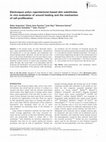
In the present study, we have fabricated electrospun poly(ε-caprolactone)-based membranes, charac... more In the present study, we have fabricated electrospun poly(ε-caprolactone)-based membranes, characterized and studied the in vivo cell migration and proliferation and wound healing activity. Moreover, we did not seed any cells prior to the animal implantation and we could observe excellent fibroblast attachment and cell proliferation. Further full thickness excision wound on guinea pig completely healed within 35 days. We could reach in an assumption that the enhanced cell proliferation and wound healing might be due to the surface degradation of the polymer under physiological conditions and the formation of functional groups like hydroxyl and carboxyl groups that promoted cell proliferation in a cell adhesion protein mediated mechanism. This study is a novel tissue engineering concept for the reconstruction of a damaged tissue without the in vitro cell seeding and proliferation prior to the in vivo implantation.








Uploads
Papers by Robin Augustine
general and antiretrovirals (ARVs) used in the therapy of the human immunodeficiency virus (HIV) infection
in particular. We anticipated that in the case of protease inhibitors, a family of pH-dependent ARVs that display
high aqueous solubility under the acid conditions of the stomach and extremely low solubility under the
neutral ones of the small intestine, this strategy will fail owing to an uncontrolled dissolution-re-precipitation
process that will take place along the gastrointestinal tract. To tackle this biopharmaceutical challenge,
in this work, we designed, produced and fully characterized a novel Nanoparticle-in-Microparticle Delivery
System (NiMDS) comprised of pure nanoparticles of the first-line protease inhibitor darunavir (DRV)
and its boosting agent ritonavir (RIT) encapsulated within film-coated microparticles. For this, a clinically
relevant combination of pure DRV and RIT nanoparticles was synthesized by a sequential nanoprecipitation/
solvent diffusion and evaporation method employing sodium alginate as viscosity stabilizer. Then, pure
nanoparticles were encapsulated within calcium alginate/chitosan microparticles that were film-coated with
a series of poly(methacrylate) copolymers with differential solubility in the gastrointestinal tract. This coating
ensured full stability under gastric-like pH and sustained drug release under intestinal one. Pharmacokinetic
studies conducted in albino Sprague Dawley rats showed that DRV/RIT-loaded NiMDSs containing
17% w/w drug loading based on dry weight significantly increased the oral bioavailability of DRV by
2.3-fold with respect to both the unprocessed and the nanonized DRV/RIT combinations that showed statistically
similar performance. Moreover, they highlighted the limited advantage of drug nanonization to improve
the oral pharmacokinetics of protease inhibitors and the potential of our novel delivery approach to improve
the oral pharmacokinetics of nanonized poorly water-soluble drugs displaying pH-dependent solubility.
general and antiretrovirals (ARVs) used in the therapy of the human immunodeficiency virus (HIV) infection
in particular. We anticipated that in the case of protease inhibitors, a family of pH-dependent ARVs that display
high aqueous solubility under the acid conditions of the stomach and extremely low solubility under the
neutral ones of the small intestine, this strategy will fail owing to an uncontrolled dissolution-re-precipitation
process that will take place along the gastrointestinal tract. To tackle this biopharmaceutical challenge,
in this work, we designed, produced and fully characterized a novel Nanoparticle-in-Microparticle Delivery
System (NiMDS) comprised of pure nanoparticles of the first-line protease inhibitor darunavir (DRV)
and its boosting agent ritonavir (RIT) encapsulated within film-coated microparticles. For this, a clinically
relevant combination of pure DRV and RIT nanoparticles was synthesized by a sequential nanoprecipitation/
solvent diffusion and evaporation method employing sodium alginate as viscosity stabilizer. Then, pure
nanoparticles were encapsulated within calcium alginate/chitosan microparticles that were film-coated with
a series of poly(methacrylate) copolymers with differential solubility in the gastrointestinal tract. This coating
ensured full stability under gastric-like pH and sustained drug release under intestinal one. Pharmacokinetic
studies conducted in albino Sprague Dawley rats showed that DRV/RIT-loaded NiMDSs containing
17% w/w drug loading based on dry weight significantly increased the oral bioavailability of DRV by
2.3-fold with respect to both the unprocessed and the nanonized DRV/RIT combinations that showed statistically
similar performance. Moreover, they highlighted the limited advantage of drug nanonization to improve
the oral pharmacokinetics of protease inhibitors and the potential of our novel delivery approach to improve
the oral pharmacokinetics of nanonized poorly water-soluble drugs displaying pH-dependent solubility.